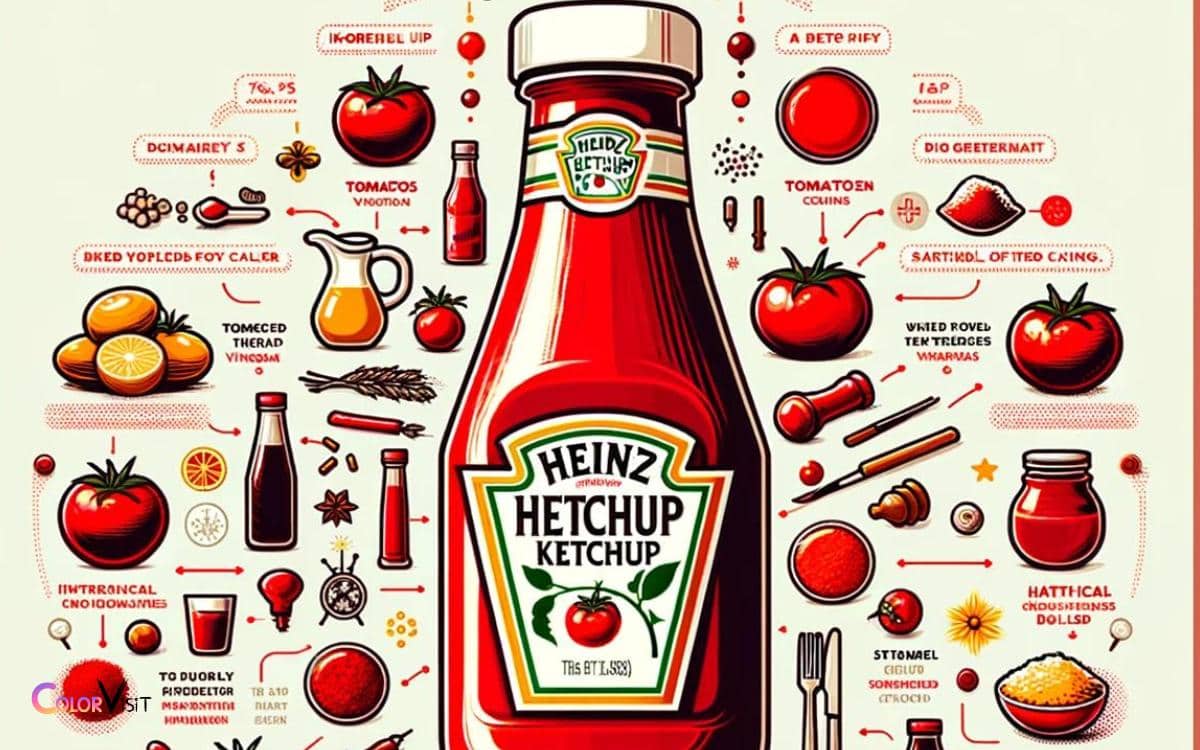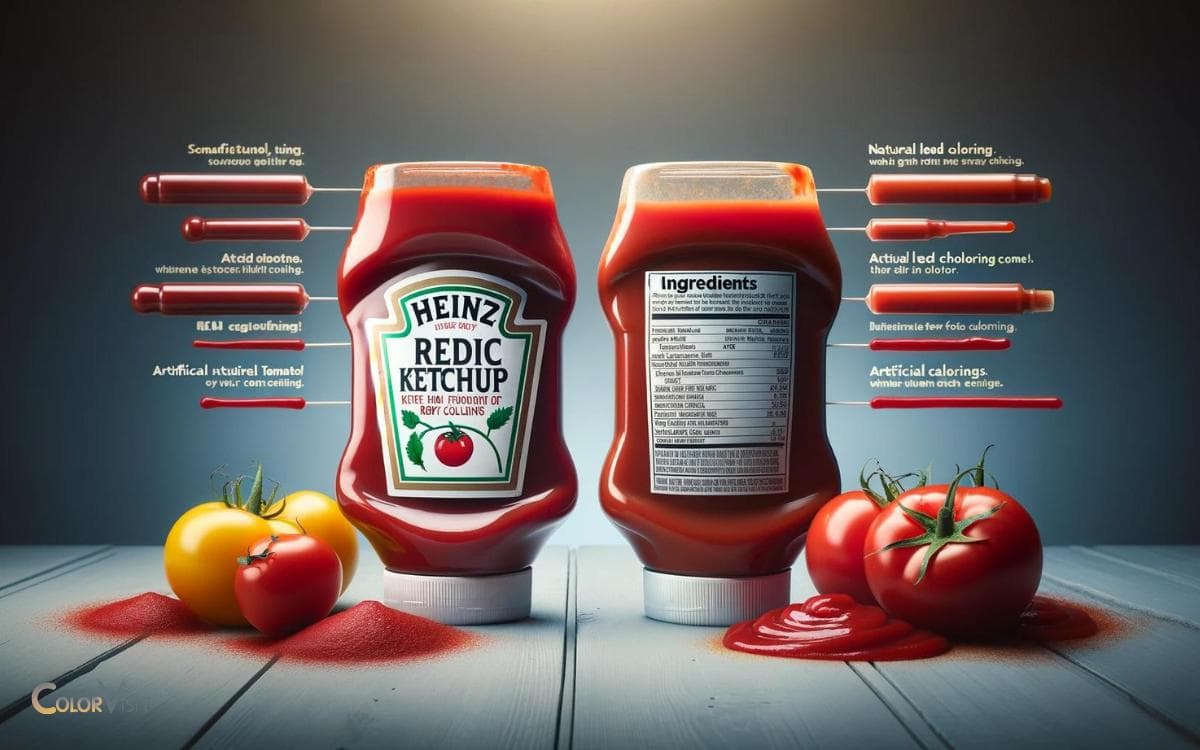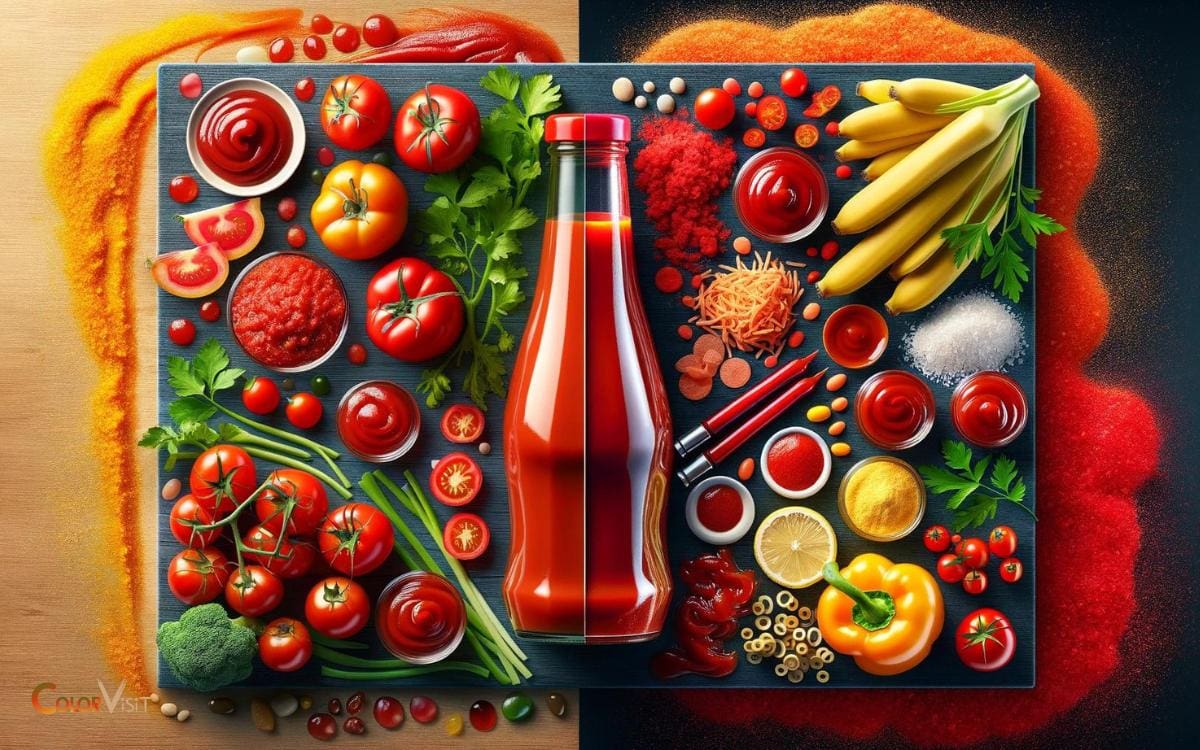Does Heinz Ketchup Have Red Food Coloring? No!
No, Heinz Ketchup does not contain red food coloring. Its red color comes naturally from ripe tomatoes.
The primary ingredient in Heinz Ketchup is ripe tomatoes, which naturally have a rich red hue.
This color is retained during the cooking and condensing process, resulting in the final product’s distinct red shade. The assumption that artificial food coloring is used is a common misconception.
Thus, the vibrant color of Heinz Ketchup is not due to artificial coloring, but the natural color of ripe tomatoes used during its production.
Key Takeaway
Understanding Heinz Ketchup Ingredients
The ingredients of Heinz Ketchup are crucial to understanding its composition and nutritional content.
- The primary ingredients in Heinz Ketchup include tomato concentrate, distilled vinegar, high fructose corn syrup, corn syrup, salt, onion powder, and natural flavoring.
- Tomato concentrate forms the base of the ketchup, providing the characteristic flavor and color. Distilled vinegar acts as a preservative while also contributing to the tangy taste.
- High fructose corn syrup and corn syrup are sweetening agents, enhancing the overall sweetness of the ketchup. Salt and onion powder add savory notes, complementing the sweetness and acidity.
- The natural flavoring further enhances the taste profile.
Understanding these ingredients is essential for analyzing the nutritional aspects and flavor profile of Heinz Ketchup, providing valuable insights for consumers and food enthusiasts seeking innovation in condiments.
Analyzing the Red Color in Heinz Ketchup
The red color in Heinz Ketchup is a result of the specific combination of ingredients used in its formulation.
The vibrant hue is a key factor in the appeal of the product and is achieved through a careful selection of components.
The analysis of the red color in Heinz Ketchup involves an understanding of the following:
- Tomato Concentrate: The primary source of the red color in Heinz Ketchup is the tomato concentrate, which undergoes processing to intensify its natural red hue.
- Additional Ingredients: Other ingredients such as vinegar, sweeteners, and seasonings can also contribute to the final red color of the ketchup.
- Processing Techniques: The manufacturing process, including heating and blending methods, plays a crucial role in maintaining the desired red color.
This meticulous analysis ensures that the red color in Heinz Ketchup meets the standards of quality and consistency expected by consumers.
Unveiling the Truth About Red Food Coloring
Unveiling the truth about red food coloring involves delving into its composition and the impact it has on the overall quality of Heinz Ketchup.
Red food coloring is a crucial component in creating the vibrant hue of Heinz Ketchup, but its composition and potential effects on health and quality warrant scrutiny.
Below is a table highlighting common ingredients found in red food colorings, shedding light on their potential impact:
| Red Food Coloring Components | Function | Potential Impact |
|---|---|---|
| Red 40 | Colorant | Allergic reactions, hyperactivity |
| Carmine | Colorant | Allergic reactions, potential carcinogenicity |
| Beet Juice | Natural colorant | Minimal adverse effects |
Understanding the components of red food coloring is essential in evaluating its suitability for Heinz Ketchup.
This analysis sets the stage for exploring natural and artificial color sources to enhance the quality and safety of food products.
Exploring Natural and Artificial Color Sources
Exploring the origins and properties of natural and artificial color sources is integral to understanding their role in food products like Heinz Ketchup.
In the quest for innovative and safe color sources, it’s crucial to consider the following:
- Natural Sources: These include plant-based sources such as turmeric, beetroot, and annatto, which provide vibrant colors without the use of synthetic additives.
- Artificial Sources: Synthetic colorants are meticulously developed to mimic natural colors and provide consistency in appearance. They are extensively tested for safety and efficacy to meet stringent regulatory standards.
- Consumer Preferences: Understanding consumer perceptions and preferences regarding natural versus artificial colors is crucial for product development and ensuring market acceptance of color choices.
Debunking Myths About Heinz Ketchup’s Red Hue
Debunking misconceptions about Heinz Ketchup’s red hue is essential for clarifying its color source.
- Contrary to popular belief, Heinz Ketchup does not contain artificial red food coloring. Instead, its vibrant red color is derived from natural sources, predominantly ripe, red tomatoes.
- The misconception of artificial coloring likely stems from the intense and consistent red hue of Heinz Ketchup, leading some to assume the presence of artificial additives.
- However, Heinz uses a meticulous process to select and process ripe tomatoes, ensuring a consistent and natural red color.
- This debunking not only clarifies the source of Heinz Ketchup’s red hue but also highlights the brand’s commitment to natural ingredients and innovation in food production.
Understanding the truth behind the red hue dispels myths and fosters an informed perspective on Heinz Ketchup.
Conclusion
The red color in Heinz ketchup is attributed to the presence of red food coloring, specifically the natural color source of tomatoes. Contrary to popular myths, Heinz ketchup does not contain artificial red food coloring.
As the adage goes, ‘Don’t judge a book by its cover,’ it is important to consider the ingredients and sources of food coloring before making assumptions about a product’s composition.






